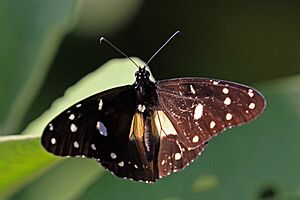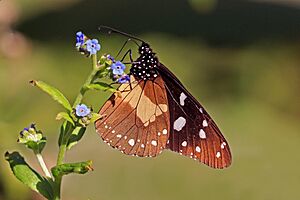Chief (butterfly) facts for kids
Quick facts for kids Chief |
|
|---|---|
 |
|
 |
|
| Both in Kakamega Forest, Kenya | |
| Scientific classification | |
| Synonyms | |
|
The Chief butterfly (scientific name: Amauris echeria) is a beautiful insect. It belongs to the Nymphalidae family, which is a large group of butterflies. You can find these butterflies flying around in southern Africa.
Contents
About the Chief Butterfly
The Chief butterfly is known for its striking appearance. It has a wingspan of about 55 to 65 millimeters for males. Females are a bit larger, with a wingspan of 63 to 70 millimeters. This means their wings stretch out about the length of your palm!
These butterflies are active all year round. However, you are most likely to see them during the summer and autumn months. This is when they are most common.
Life Cycle and Food
Like all butterflies, the Chief butterfly starts its life as a larva, also known as a caterpillar. These caterpillars need specific plants to eat and grow. They feed on several types of plants. These include Tylophora anomala, Tylophora stolzii, and Cynanchum chirindense.
They also enjoy plants from the Gymnema family, like Gymnema sylvestre. Other food sources are Marsdenia plants, such as Marsdenia angolensis and Marsdenia racemosa. Finally, they munch on Secamone plants, including Secamone africana and Secamone parviflora. These plants are important for the caterpillars to grow big and strong before they turn into butterflies.
Different Kinds of Chief Butterflies
Just like people from different parts of the world might look a little different, butterflies can also have variations. These variations are called subspecies. The Chief butterfly has many different subspecies, each found in a specific area.
For example, the A. e. echeria subspecies lives from the Cape to Natal in South Africa. Another one, A. e. jacksoni, is found in Kenya, west of the Rift Valley. These small differences help scientists understand how species adapt to their local environments.
Images for kids


